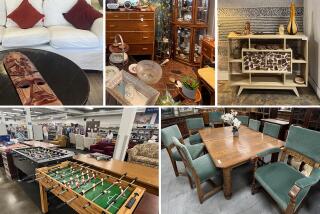Notes on Biedermeier Antiques : SHOPPING FOR ANTIQUES : Biedermeier Furniture
- Share via
FURNITURE AND decorative arts of the Biedermeier period are now in vogue among collectors and interior designers. It was a brief era that lasted from the Congress of Vienna in 1814 to the Revolution of 1848. Originating in Austria and Germany, the Biedermeier style was comfortably middle class. The name was taken from a Viennese journal of the day that had humorous articles about Gottlieb Biedermeier (“Plain Meier”), a fictional everyman caricaturing middle-class taste--or lack of it.
True enough, in its later development, the style did move in the direction of bourgeois overstatement and tastelessness, but examples from the earlier years display a simplicity of design. The furniture was elegant and spare, particularly if compared to the French Empire style, then popular in the Austrian Empire and elsewhere in Europe. (After the defeat of Napoleon, however, German and Austrian designers stripped Empire furniture of its bronze mounts and exotic woods but kept its characteristic saber legs and architectural pediments.) Typically, it was made of plain cherry, birch and walnut. From bourgeois apartments to the palaces of the nobility, it was enormously popular.
Furniture makers of the period used wood with great skill, and they took pains to emphasize the grain, since it provided the only real decoration. It was also (for almost the first time in the history of European furniture) heavily coated with shellac and without the wax finish used on most 18th-Century furniture. Glossy surfaces were polished like mirrors, contrasting sharply with the softer look of wood treated with wax. The flashy ormolu of the Empire style was replaced with columns and moldings of lovely wood--simple, elegant, unpretentious.
The middle class of the day, however, did not necessarily believe that “less is more,” and showy decoration often appeared in the fabric used to cover chairs and sofas. Fabric was of great importance, because it was one of the best ways for the bourgeois to advertise wealth. All kinds of furniture were produced: Love seats and small desks are often imaginative; dining-room chairs with lyre-shaped backs are particularly appealing.
Authentic Biedermeier pieces are expensive and not easy to find. Be aware that many reproductions were made, particularly during the first decades of the present century.
Look for Biedermeier pieces at Charles Pollock, Quatrain, Rose Tarlow/Melrose House and Morey Palmer Associates in West Los Angeles; Antique Showcase in Encino; Richard Yeakel and Nicholson’s in Laguna Beach; Connoisseur in San Diego; Antique Collection in Ojai, and Pasadena Antique Center in Pasadena.


